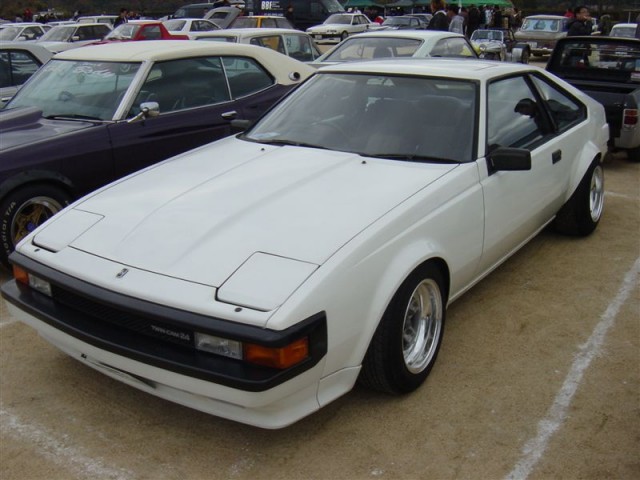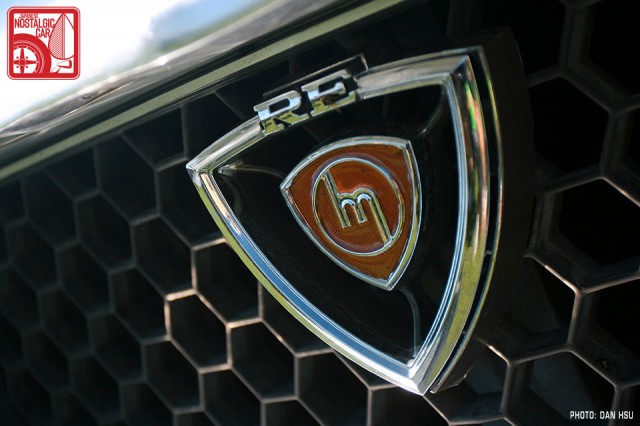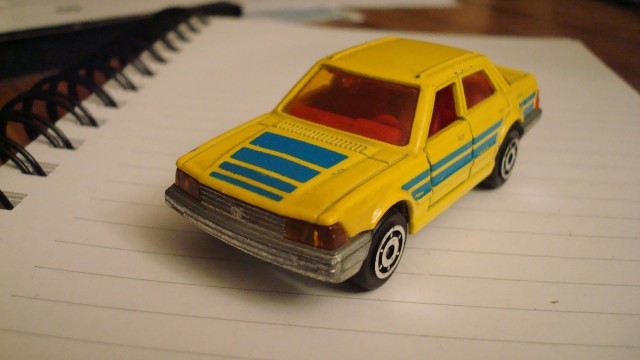
Rarely is the follow-up better than the original, but when it is, it’s not just slightly better — it blows the original away. That is why we ask:
What’s the best sequel?
We just spent a weekend at 86Fest, so there was much AE86 and Scion FR-S co-mingling. However, it remains to be seen whether the latter will out do the original in the annals of history to come. Our choice is Toyota Supra. It only got better with each of its four generations, from quasi-luxurious GT to paradigm-shifting sports coupe, to turbocharged Wangan beast to supercar-destroying icon.
What say you, dear reader? As always, the most entertaining or inspiring comment by next Monday will receive a random toy. Click through to see the winner from last week’s question, “What’s the best Japanese car emblem?”

The winner this week was The Black CRX, who made a remarkably un-biased choice by nominating not a Honda badge but the Mazda rotary.
I’ve always loved Mazda’s simple rotary logo. Graphic, symmetrical, scalable and simple, yet unique and identifiable. Any logo that takes an actual element of the brand’s product and turns it into an icon already tends toward greatness, but it’s even stronger when the design is also a near-literal depiction of its most significant attribute.
Compare it to the awkward boxer logo on a new Scion FR-S and you can understand why Subaru looked to the stars instead of under their own hood for their own lovely Pleiades logo.
Perhaps the best testament to how right the Mazda logo can be seen in how many times they searched for a suitable replacement logo, once they chose not to pin their image on their rotary history… the lonely stylized type that stayed around through the 1990s, the “pen nib” of 1993, and today’s mustachio-like wings in a box just don’t have the power of the iconic little rotor.
Omedetou! Your prize from the JNC gashapon is a Majorette Honda Accord sedan.







Arigatou gozaimasu, Ben! I will treasure the diecast Accord (and maybe look for a low-mile full-size counterpart now).
As for this week’s question, I’ll be un-unbiased and say the Honda Prelude. And like the Supra (or Toy Story, Shrek, Fast Five and perhaps Sanjuro), I think the second iteration was the pinnacle of the series.
And it’s one step more exotic than JDM – being a Majorette, it comes avec French yellow headlights!
An easy answer would be any Z car following the original. Nissan fumbled with the S130 in terms of design and lack of any major technical advances. The Z31 came and picked it back up, the Z32 drove it hard to the goal and the Z33 scored in all categories. While the Z34 went a little overboard with Nissan’s new design language, the fact that the company (at the time) had the guts to chop the wheelbase down and bulge the rear arches to insane-for-production-car levels to accompany the new powerplant is definitely deserving of some endzone celebration.
how are the sports metaphors working for you? i actually hate football.
my real answer would be the evolution of the Mitubishi Lancer, right up to the Evo IX before things got blown out of proportion. Or the Mazda RX7 line right up to the non-sequitur RX8…
But for serious, the only real answer is the Toyota X-chassis. From the x10 Mark II to the X120 Mark X, the lineage of what was once Toyota’s Stateside flagship has continually improved and adapted to suit the times.
The X-chassis has underpinned sedans, coupes and wagons over the decades. It has been raced in professional series and by amateurs in somewhat less-than-legal contests on Japan’s expressways. Today it wouldn’t be impossible to see an X3 sliding door-to-door with its descendents from any generation up to current at a drift event, or ordered by age at a parking area. You’d have a great opportunity to see how Toyota has advanced in terms of design and technology, from carbureted to DOHC and turbocharged inlines and direct-injected vee sixes. From simple solid axles to complex fully-independent suspensions. From manual toggles and radial knobs when multiple speakers were an option to fully automatic cabins loaded with every conceivable luxury and convenience amenity as standard.
Once again, like your QotW regarding mini-pickups, you answered your own question.
Honda “S” chassis cars.. ok, yeah, there is like a 30 year gap.. but the soul remained the same, and was improved upon. but let’s be honest here, i wouldn’t kick any of them out of bed and what practically pee myself to drive any of them every day. i’m lookin at you Kuroneko. mad jealous..
The Toyota MR2 Spyder. While many would go this route. I have owned 6 different MR2s and autocrossed each one. Although the first gen was light and quick, gen 2 brought in power but suspect handling in 91-92. In terms of mid-engined rear drive handling, nothing comes close. Its car you can push to the limits and not fear losing it or spinning out. The car just handles like a dream. The car is lighter than the previous models and follows the tradition of Toyota building lightweight, fun sports car. Let’s not forget it is the last Toyota badged car you can available in the states. The build quality is excellent and being a roadster is a bonus.
It may not qualify for Japanese Nostalgic car status yet, but the first ones are 13 years old and we are talking a lineage that started close to 30 years ago.
how does a person win these die-cast cars for these articles.
The instructions are above, in the article
RX-7. Each of the three generations was a great car for the market at the time, and yet Mazda were able to develop and evolve the formula, taking the same basic engine and layout and making it better. In particular, the FD was an incredible almost clean-sheet re-imagining of the turbo rotary sports car, designed with single-minded perfectionism throughout, from forged alloy suspension arms to rigid power plant frame to sequential twin turbo system.
Sometimes the best sequels are spiritual sequels. Like “Snatch” to “Lock Stock and Two Smoking Barrels” or “Shadow of the Colossus” to “Ico” or even “Portal” to “Narbacular Drop”. Sometimes you take everything that was good about the original, throw away everything that was bad and add in a Yamaha derived straight six. Because, you know, anything Yamaha derived is awesome.
That’s right, I’m talking about the Toyota 2000GT to the Toyota Sports 800. The styling carried over, as did the two-seater sports car persona. It grew in size though, so that even suave, British, secret agents could fit inside (granted they still had to cut the top off to fit him in it). The engine also went from an 800 cc flat twin based on the Publica to a screaming, twin cam, 2000 cc, inline six. This appropriately bumped power from 45 hp to an awesome 150! The suspension was also improved from the awkward torsion beam setup that sent the beams right between your legs in the Sports 800 to a double wishbone with coil spring setup in the 2000GT. Then, as a sweet little cherry on top, drum brakes changed to four wheel discs, assuring that you could stop the one of only 300 missile that you were careening through the mountain passes.
It took every aspect of the original and made it better while managing to retain the same charm that made us all love the original in the first place. That is how it’s done. Now, if only Hollywood could figure that out.
The RX7 gets my vote. The first generation is still iconic to this day. The second generation was a little bland for my taste, but was a definite improvement. And of course the third generation was the most beautiful car ever to come out of Japan.
The Mazda Miata NA. It was “the sequel” to all the roadsters from Great Britain, Japan, and Fiat. It replaced them in the driveways of casual owners who wanted something sporty, serious motorists who wanted something traditional, and racers who wanted something that won on Sunday.
First there was Mario Puzo’s The Godfather, which is arguably the greatest movie of all time, then came Godfather II which was also phenomenal. Then came Godfather III… Right. So with this logic of first being the best, second being almost as good and then third being… well you get the point, you would think that the RX7 by its third generation wouldn’t have been all that great, but No! Now take my strange movie logic and invert it and you essencially have the love story that is The RX7. The Savanna RX7 started out great, then with its sequel became better, but then BAM! With the Third generation Mazda created an iconic legend that to this day takes up wall space in my room over a Ferrari anyday. The FD RX7 is timeless, it is art, and it is possibly the greatest car to have come from Mazda; it was the sequel of the sequel that the Rotary World Deserved!
i would most definately agree the Supra is probably hte best car of coice… followed by the RX-7…
Civic.. up to the EP.
California, 1957
“What is it?”
“It’s a Toyopet Crown!”
“Huh?”
“It’s a car.”
“And you want me to sell it? Well, what can it do?”
“We will take it across this great country, in a special endurance test, to show off the glory of Japan!”
“Ok, I’ll drive.”
Las Vegas, 1957
“We are failure! Crown is putz!!!”
And that is the story of how the greatest sequel in car history came to be.
Thank You.